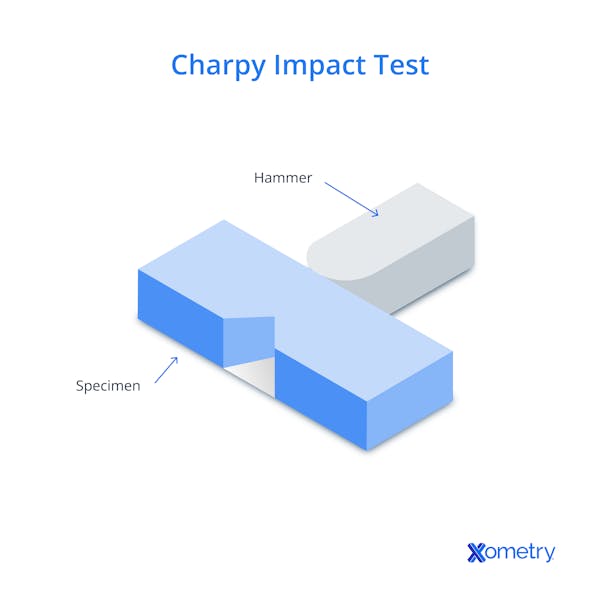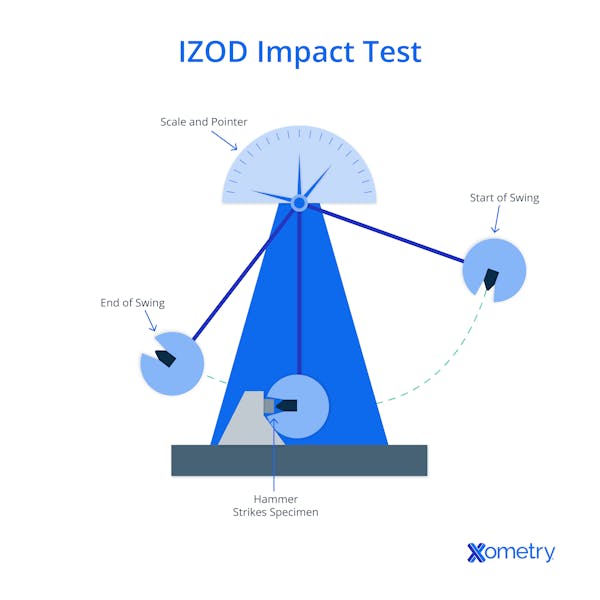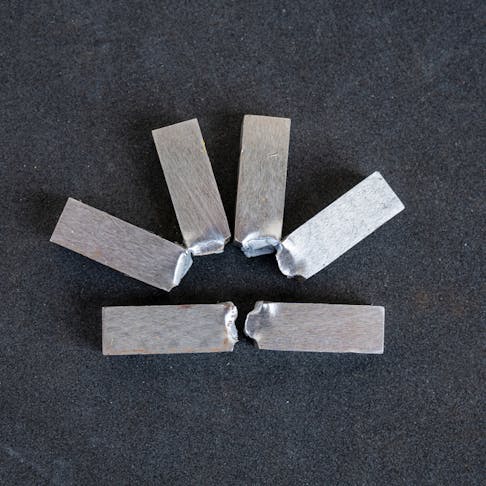Impact strength is the measure of the ability of a material to resist cracking, fracturing, or plastic deformation under sudden and intense impact, or shock loads. It is a critical property that determines the material's ability to withstand sudden forces. Designing components that will be subjected to high impact or shock loads hinges upon an understanding of these measurements, to allow for potential failures. The impact strength of a material is usually quantified using the IZOD test or Charpy tests. These are indicative and standardized tests, used to grade materials. However, they are not representative of real use and provide limited information about cyclic or real-world loading. This article will describe impact strength, how it is calculated, its importance, the factors that affect it, and the different types of impact strength failures.
What Is Impact Strength?
Impact strength is a measure of the ability of a material to resist fracture under shock and impulse loading. It is only applicable to materials that undergo brittle fracture. It is also used in the testing of ductile materials that display temperature-dependent and/or impulse-dependent brittle-ductile transition. Many materials that are ductile under “normal” loading and operational conditions can display brittle behavior when cold and/or impacted suddenly. Evaluating these behaviors is informative in product design and material selection.
What Is the Importance of Impact Strength?
Understanding the impact behaviors of materials is a critical piece of design information that drives both material selection and detailed design. Components that are likely to suffer high impulse (i.e., short period) impacts must be made to resist the catastrophic effects that these can create.
Good design of resilient products requires various behaviors to be understood in addition to basic impact strength. Understanding properties such as fatigue, microfracture, and mixed ductile/brittle behaviors also contribute to reducing/avoiding making products that fail prematurely in service. Service life is particularly important in many areas. It enables preventative maintenance and drives an understanding of inspection processes and schedules to prevent failures.
How Is Impact Strength Calculated or Measured?
Listed below are the two methods for calculating impact strength:
1. Charpy Impact Test
The Charpy test is less commonly used than the IZOD test and results in a measurement of absorbed Charpy V impact energy, in Joules. This is measured by the post-impact travel of the hammer, as the remaining energy is dissipated in the continued swing of the swing hammer.

2. IZOD Test
The ASTM impact energy is measured in J/m or ft-lb/in. Impact strength results from dividing the value for impact energy in (J or ft-lb) by the notch thickness (mm or inches) of the specimen, for an average of 5 test cycles. The ISO method is slightly different, deriving impact strength with units kJ/m2 from the impact energy in J by the area under the notch. This test is performed on 10 specimens and the results are averaged.

What Are the Factors That Affect the Impact Strength of Materials?
Listed below are the factors that affect the impact strength of material:
1. Material Thickness
Thicker material will influence strength by providing more structure/bonds that may need to be broken to achieve fracture.
2. Temperature
Many materials show significant changes in properties as temperature changes. Characterizing these alterations is a critical part of the material definition/testing process, and both IZOD and Charpy tests are performed at a range of standard temperatures.
Metals, in particular, have an annealing temperature, at which they can become more self-healing. Aluminum, for example, anneals at 570°F, so all crystal boundaries blend into each other and the material becomes very ductile. Some materials suffer embrittlement at low temperatures. Many materials weaken as they get hotter, with unusual transitions being evident at temperatures such as the onset of glass transition.
3. Notch Radius
Stress concentration is a major factor in material strength. A sharp-tipped notch will promote fracture by focusing the stress at a point, so notch radius is critically important in comparing tests for like materials.
What Are the Different Types of Impact Strength Failures?
Listed below are the different types of impact strength failures:
1. Brittle Fracture
A brittle fracture is one in which a sample of material has parted into two or more parts. These parts can be refitted together to form the original shape/outline of the part. A cracker undergoes brittle fracture, when fresh and crisp.
2. Ductile Fracture
A ductile fracture is a rare occurrence. Ductile failure modes occur when a material necks irreversibly (i.e., undergoes plastic deformation) and extensively. In general, a massive ductile failure in a tensile test piece looks like a plasticine that has been pulled to form a neck. This is generally followed by a small brittle fracture that can fit back together neatly—rather than extending to a hair-fine thread.
3. Yielding
Yielding is a feature of elastic materials that reach their elastic limit and then undergo plastic distortion. When experiencing forces below the yield point, the material will return to the original shape/dimensions when the force is released. On the other hand, when the yield point or yield strength is exceeded, the material will undergo some plastic (i.e. permanent deformation). When the force is released, the material will recover its elastic distortion, but not the plastic component.
4. Slight Cracking
The purpose of both Charpy and IZOD tests when correctly performed is the parting or fracture of the material sample, into two or more pieces. If the sample is only slightly damaged or partially broken, a higher energy or deeper notch test may be appropriate. The failure can be achieved from a mixture of modes—shear, ductile, and brittle. Failure types are listed as: complete break, hinged break, incomplete break, and non-break.
How Does Impact Strength Relate to 3D Printing?
Most 3D-printed plastics display considerably lower impact strength than a molded or machined block of the same material. This is a function of the anisotropic properties of the construction methods used for 3D printing and can relate significantly to the build orientation. For example, FDM parts offer generally better inter-layer bonding than they do intra-layer, so the models have a reasonable degree of strength in the X-Y plane of the build but are very much weaker along the Z axis. This variation/directionality is true of other model types, to a varying degree.
What Is the Ideal Impact Strength for a 3D Printed Material?
The ideal impact strength for a 3D-printed material varies depending on the material characteristics. In general, the impact strength of FDM printed parts in, for example, PLA is close to zero across the Z axis and up to 23 kJ/m2 across the X-Y axes in Charpy tests.
What Are the Applications of Impact Strength?
While impact strength testing cannot provide an absolute reference point in the design of components, it is a necessary scaling measurement. Listed below are some applications of impact strength:
- The relative strength of materials.
- Failure modes under “normal” adverse conditions. These results can inform the design process, by improving stiffness and energy dissipation for components. It helps improve real-world performance by, for example, better tolerating ductile distortion that may predictably occur.
- Understanding temperature performance, to allow the selection of materials suited to the expected working conditions for the part.
- Understanding other environmental factors such as moisture exposure/absorption and its effect on parts.
What Are Examples of the Impact Strength of Some Materials?
Material impact testing is an area of mixed outcomes. Not all testing is as rigorous as it should be. Material manufacture can introduce variability that is not apparent until failure. In metals, heat treatment, and the resulting crystalline structure alterations, can have far-reaching effects that are hard to understand or quantify. Alloying agents are similarly important, though less hidden. Finally, manufacturing processes can alter performance so markedly that basic material testing can be uninformative. A good example is the difference between a forged and a cast steel part made in the same material. The raw material is identical, but the forged part can be orders of magnitude stiffer, stronger, and more fracture resistant.
What Is the Impact Strength of Plastic?
The impact strengths of some common polymers are shown in Table 1 below:
| Polymer | Min IZOD value (J/m2) | Max IZOD value (J/m2) |
|---|---|---|
Polymer ABS - Acrylonitrile Butadiene Styrene | Min IZOD value (J/m2) 200 | Max IZOD value (J/m2) 215 |
Polymer ASA - Acrylonitrile Styrene Acrylate | Min IZOD value (J/m2) 100 | Max IZOD value (J/m2) 600 |
Polymer HDPE - High Density Polyethylene | Min IZOD value (J/m2) 20 | Max IZOD value (J/m2) 220 |
Polymer HIPS - High Impact Polystyrene | Min IZOD value (J/m2) 50 | Max IZOD value (J/m2) 350 |
Polymer LDPE - Low Density Polyethylene | Min IZOD value (J/m2) 999 | Max IZOD value (J/m2) 999 |
Polymer LLDPE - Linear Low Density Polyethylene | Min IZOD value (J/m2) 54 | Max IZOD value (J/m2) 999 |
Polymer PA 66 - Polyamide 6-6 | Min IZOD value (J/m2) 50 | Max IZOD value (J/m2) 150 |
Polymer PBT - Polybutylene Terephthalate | Min IZOD value (J/m2) 27 | Max IZOD value (J/m2) 999 |
Polymer PC - Polycarbonate | Min IZOD value (J/m2) 80 | Max IZOD value (J/m2) 650 |
Polymer PET - Polyethylene Terephthalate | Min IZOD value (J/m2) 140 | Max IZOD value (J/m2) 140 |
Polymer PETG - Polyethylene Terephthalate Glycol | Min IZOD value (J/m2) 50 | Max IZOD value (J/m2) 50 |
Polymer PMMA - Polymethyl methacrylate/Acrylic | Min IZOD value (J/m2) 10 | Max IZOD value (J/m2) 25 |
Polymer POM - Polyoxymethylene (Acetal) | Min IZOD value (J/m2) 60 | Max IZOD value (J/m2) 120 |
Polymer PP - Polypropylene 10–20% Glass Fiber | Min IZOD value (J/m2) 50 | Max IZOD value (J/m2) 145 |
Polymer PTFE - Polytetrafluoroethylene | Min IZOD value (J/m2) 160 | Max IZOD value (J/m2) 200 |
Polymer PVC Rigid | Min IZOD value (J/m2) 20 | Max IZOD value (J/m2) 110 |
Table Credit: https://omnexus.specialchem.com/
| Metal/Alloy | Charpy Values (Joules) | Charpy Values (ft.lbs) |
|---|---|---|
Metal/Alloy 1040 Carbon steel (normalized) | Charpy Values (Joules) 180 | Charpy Values (ft.lbs) 133 |
Metal/Alloy 8630 low alloy steel | Charpy Values (Joules) 55 | Charpy Values (ft.lbs) 41 |
Metal/Alloy 410 stainless steel | Charpy Values (Joules) 34 | Charpy Values (ft.lbs) 25 |
Metal/Alloy L2 tool steel | Charpy Values (Joules) 26 | Charpy Values (ft.lbs) 19 |
Metal/Alloy Ductile (soft) Iron, quenched | Charpy Values (Joules) 9 | Charpy Values (ft.lbs) 7 |
Metal/Alloy 2048 Aluminum | Charpy Values (Joules) 10.3 | Charpy Values (ft.lbs) 7.6 |
Metal/Alloy AZ31B Magnesium | Charpy Values (Joules) 4.2 | Charpy Values (ft.lbs) 3.2 |
Metal/Alloy AM100A cast Magnesium | Charpy Values (Joules) 0.8 | Charpy Values (ft.lbs) 0.6 |
Metal/Alloy Titanium, Aluminum Tin alloy | Charpy Values (Joules) 23 | Charpy Values (ft.lbs) 17 |
Metal/Alloy Aluminum Bronze | Charpy Values (Joules) 48 | Charpy Values (ft.lbs) 35 |
Metal/Alloy Monel | Charpy Values (Joules) 298 | Charpy Values (ft.lbs) 220 |
Metal/Alloy Refractory metal | Charpy Values (Joules) 174 | Charpy Values (ft.lbs) 128 |
Table Credit: https://www.feis.unesp.br/
A few Charpy test data examples are included to understand the range.
What Is the Strongest Impact-Strength Metal?
In research outcomes, the highest Charpy test value ever achieved was for a metal composite sample (~450J). It was for a laminated block of alternating sheets of hot roll bonded ferrite and martensite steels.
Which Device Is Used To Measure the Impact Strength of the Material?
In both the IZOD and Charpy tests, the sample is impacted by a swing hammer whose energy can be adjusted with a higher or lower bob weight. In IZOD testing, the sample is generally clamped at one end, mounted vertically, and it can be notched or (less commonly) not. The notch can face the hammer or be reversed. Though the measurements should, in principle, vary little, consistency in any test cycle is important. In Charpy testing, the sample bridges the horizontal gap between two supports that it rests on. The hammer swings between these supports and is heavier for higher-strength materials.
What Is the Difference Between Impact Strength and Tensile Strength?
Impact strength defines the ability of a component to resist distortion and fracture when laterally impacted and one or both ends are supported. Tensile testing applies a longitudinal load to one end of a sample, while the other end is firmly retained in a 2D collet. Tensile capacity is a clearer measure with a better-quantified output, which translates into simple, calculable strength in tension, for components.
Summary
This article presented impact strength, explained what it is, and discussed what it means in manufacturing. To learn more about impact strength, contact a Xometry representative.
Xometry provides a wide range of manufacturing capabilities, including 3D printing and other value-added services for all of your prototyping and production needs. Visit our website to learn more or to request a free, no-obligation quote.
Disclaimer
The content appearing on this webpage is for informational purposes only. Xometry makes no representation or warranty of any kind, be it expressed or implied, as to the accuracy, completeness, or validity of the information. Any performance parameters, geometric tolerances, specific design features, quality and types of materials, or processes should not be inferred to represent what will be delivered by third-party suppliers or manufacturers through Xometry’s network. Buyers seeking quotes for parts are responsible for defining the specific requirements for those parts. Please refer to our terms and conditions for more information.

